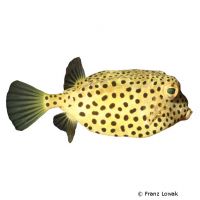Yellow Boxfish (Ostracion cubicus)
| Yellow Boxfish Ostracion cubicus | |
|---|---|
| Name | Yellow Boxfish |
| Name Lat. | Ostracion cubicus |
| Family | Boxfishes |
| Family lat. | Ostraciidae |
| Order | Puffers & Filefishes |
| Order lat. | Tetraodontiformes |
| Origin | Indo-Pacific |
| Habitat | Lagoons, seaward reefs |
| Diet | Omnivore |
| pH | 8.1-8.4 |
| Hardness | 8-10 °KH |
| Behavior | Semi-aggressive |
| Keeping | Individual |
| Reef Compatible | Yes |
| Care Level | Difficult |
| Life Span | 8-10 years |
| Protection | No |
| Metric Units | |
| Size | 45 cm |
| Temperature | 24-28 °C |
| Salinity | 33-36 ‰ |
| Aquarium | ~ 2.000 l |
| US Units | |
| Size | 18" |
| Temperature | 75-82 °F |
| Salinity | 1.020-1.025 sg |
| Aquarium | ~ 500 gal |
Distribution and habitat
The Ostracion cubicus is found in the tropical Indian and Pacific Oceans, from the east coast of Africa to the west coast of Central and Central America. They live there in lagoons and on protected outer reefs mostly among corals.
Maintenance
They require a well-structured aquarium with plenty of swimming space with a weak current and a reef structure (hiding and retreat possibilities) with living stones which they can graze on and which act like a biological filter as well as fine-grained sand surfaces. Only lime-rich, heavy metal-free substrates may be used as substrate
Filters, skimmers and heaters are necessary to ensure water quality, as well as pumps to simulate tides, swells and bottom currents. Lighting must match the species-appropriate day-night rhythm of the animals
| Salinity: 33-36 ‰ | pH value: 8.1-8.4 |
| Carbonate hardness: 8-10 °KH | Nitrate content: 2-8 mg/l |
| phosphate content: 0.01-0.1 mg/l | nitrite content: 0.0-0.05 mg/l |
For salinity, an average value should be aimed for, which may only vary slightly by +/- 0.5 ‰. Ammonia and ammonium must not be measurable. Special attention must be paid to constantly good water quality.
Diet
They feed mainly on small crustaceans. Feeding live Artemia and red mosquito larvae will help with the not unproblematic food change. After acclimation, the food supply should consist of a commercial frozen food mix enriched with vitamins or a combination of live or frozen food such as mysis, krill and Artemia with small cut fish, mussel and squid meat. In addition, they need algae and seaweed (e.g., nori, caulerpa, kelp). High quality granulated or flake food is also usually well accepted. It is recommended to feed these slow eaters small portions several times a day (3-5 times). Regular and varied feeding promotes health and increases resistance.
Behaviour and compatibility
They are intraspecific incompatible and behave also towards other boxfish very aggressive. Keeping them in pairs is only possible in a much larger and richly structured tank. They can be well socialized with other calm fish.
Sex dimorphism
There are no known external distinguishing characteristics.
Reproduction and breeding
There are no known reports of successful breeding in the aquarium.
Important
In stressful situations, injury or death, they can release a potent toxin (ostracitoxin) from skin glands, endangering other fish
The slow eaters are not able to take larger chunks with their small mouth and often suffer from food competition when socialized with other fish
As reef dwellers, they should be kept together with corals and not in a fish-only aquarium; only tubeworms should be kept with caution
If different species are kept together, care should be taken to match the fish in terms of water quality and temperature requirements and social behavior, and to ensure that the setup meets the needs of all species kept together. New fish to be introduced must be acclimated slowly to the water in the aquarium
Further literature can be found in your pet store.
References
Text: Werner Winter; Image: Franz Lowak
Source: KUITER, DEBELIUS (2007): Atlas der Meeresfische: Die Fische an den Küsten der Weltmeere, Kosmos Verlag; PATZNER & MOOSLEITNER (1999): Meerwasser Atlas Bd. 6, Mergus Verlag; ENGELMANN (2005): Zootierhaltung - Tiere in menschlicher Obhut: Fische, Verlag Harri Deutsch
- Gemäß § 21 Abs. 5 Tierschutzgesetz idgF
